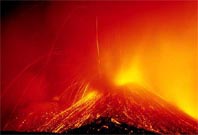'Lava bomb Earth' buried surface under 15 km of molten rock
 A new study claims that bouts of cataclysmic volcanism were experienced by the ancient Earth that buried much of its surface in up to 15 kilometres of lava.
A new study claims that bouts of cataclysmic volcanism were experienced by the ancient Earth that buried much of its surface in up to 15 kilometres of lava.
These dreadful episodes of volcanic activity each lasted for around one million years - but the last ended around three billion years ago, and the phenomenon is unlikely to occur again, informs the research from the Australian National University, in Canberra
Computer models of Earth's deep interior were used by study author Geoff Davies, which revealed that for much of its early history, the planet's innards were a ticking time bomb.
It has also been put forward by the study, published this week in the journal Earth and Planetary Science Letters as to how Earth's first continents formed in several major bursts, two to three billion years ago.
Model by Davies suggests that the barrier deep in the Earth's mantle was formed due to the early oceanic crust that was pushed far below the surface.
The molten rock was continuously prevented by this layer from rising and cooling, thus permitting vast amounts of energy to bottle up, before it finally erupted with catastrophic effect.
Davies informed, "The deeper mantle is slowly heated by radioactivity. Eventually it gets hot enough to break through the barrier and rises in a rush [which]… erupts as lava flow. These lava flows could pile up to a thickness of 10 to 15 km over much of the Earth."
He concluded, "As well as providing the raw matter to form the continents, the epic explosions would have profoundly altered the chemistry of the oceans and atmosphere. This meant that only the toughest primitive bacteria would have survived long enough for the planet's tectonic plates to thicken and the phenomenon to come to an end."